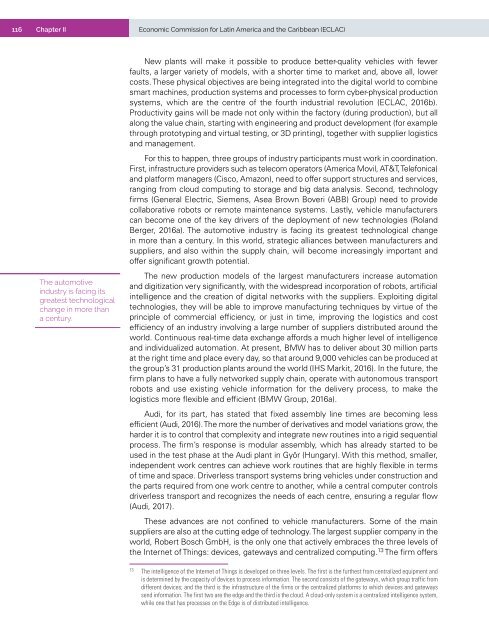Foreign Direct Investment in Latin America and the Caribbean 2017
This publication sets out and analyses the main foreign direct investment (FDI) trends in the countries of Latin America and the Caribbean. The 2017 edition shows that the region is at a difficult juncture. FDI inflows declined by 7.9% in 2016, to US$ 167.043 billion, representing a cumulative fall of 17.0% since the peak in 2011. The fall in commodity prices continues to affect investments in natural resources, sluggish economic growth in several countries has slowed the flow of market-seeking capital, and the global backdrop of technological sophistication and expansion of the digital economy has concentrated transnational investments in developed economies.
This publication sets out and analyses the main foreign direct investment (FDI) trends in the countries of Latin America and the Caribbean. The 2017 edition shows that the region is at a difficult juncture. FDI inflows declined by 7.9% in 2016, to US$ 167.043 billion, representing a cumulative fall of 17.0% since the peak in 2011. The fall in commodity prices continues to affect investments in natural resources, sluggish economic growth in several countries has slowed the flow of market-seeking capital, and the global backdrop of technological sophistication and expansion of the digital economy has concentrated transnational investments in developed economies.
You also want an ePaper? Increase the reach of your titles
YUMPU automatically turns print PDFs into web optimized ePapers that Google loves.
116 Chapter II Economic Commission for Lat<strong>in</strong> <strong>America</strong> <strong>and</strong> <strong>the</strong> <strong>Caribbean</strong> (ECLAC)<br />
The automotive<br />
<strong>in</strong>dustry is fac<strong>in</strong>g its<br />
greatest technological<br />
change <strong>in</strong> more than<br />
a century.<br />
New plants will make it possible to produce better-quality vehicles with fewer<br />
faults, a larger variety of models, with a shorter time to market <strong>and</strong>, above all, lower<br />
costs. These physical objectives are be<strong>in</strong>g <strong>in</strong>tegrated <strong>in</strong>to <strong>the</strong> digital world to comb<strong>in</strong>e<br />
smart mach<strong>in</strong>es, production systems <strong>and</strong> processes to form cyber-physical production<br />
systems, which are <strong>the</strong> centre of <strong>the</strong> fourth <strong>in</strong>dustrial revolution (ECLAC, 2016b).<br />
Productivity ga<strong>in</strong>s will be made not only with<strong>in</strong> <strong>the</strong> factory (dur<strong>in</strong>g production), but all<br />
along <strong>the</strong> value cha<strong>in</strong>, start<strong>in</strong>g with eng<strong>in</strong>eer<strong>in</strong>g <strong>and</strong> product development (for example<br />
through prototyp<strong>in</strong>g <strong>and</strong> virtual test<strong>in</strong>g, or 3D pr<strong>in</strong>t<strong>in</strong>g), toge<strong>the</strong>r with supplier logistics<br />
<strong>and</strong> management.<br />
For this to happen, three groups of <strong>in</strong>dustry participants must work <strong>in</strong> coord<strong>in</strong>ation.<br />
First, <strong>in</strong>frastructure providers such as telecom operators (<strong>America</strong> Movil, AT&T, Telefonica)<br />
<strong>and</strong> platform managers (Cisco, Amazon), need to offer support structures <strong>and</strong> services,<br />
rang<strong>in</strong>g from cloud comput<strong>in</strong>g to storage <strong>and</strong> big data analysis. Second, technology<br />
firms (General Electric, Siemens, Asea Brown Boveri (ABB) Group) need to provide<br />
collaborative robots or remote ma<strong>in</strong>tenance systems. Lastly, vehicle manufacturers<br />
can become one of <strong>the</strong> key drivers of <strong>the</strong> deployment of new technologies (Rol<strong>and</strong><br />
Berger, 2016a). The automotive <strong>in</strong>dustry is fac<strong>in</strong>g its greatest technological change<br />
<strong>in</strong> more than a century. In this world, strategic alliances between manufacturers <strong>and</strong><br />
suppliers, <strong>and</strong> also with<strong>in</strong> <strong>the</strong> supply cha<strong>in</strong>, will become <strong>in</strong>creas<strong>in</strong>gly important <strong>and</strong><br />
offer significant growth potential.<br />
The new production models of <strong>the</strong> largest manufacturers <strong>in</strong>crease automation<br />
<strong>and</strong> digitization very significantly, with <strong>the</strong> widespread <strong>in</strong>corporation of robots, artificial<br />
<strong>in</strong>telligence <strong>and</strong> <strong>the</strong> creation of digital networks with <strong>the</strong> suppliers. Exploit<strong>in</strong>g digital<br />
technologies, <strong>the</strong>y will be able to improve manufactur<strong>in</strong>g techniques by virtue of <strong>the</strong><br />
pr<strong>in</strong>ciple of commercial efficiency, or just <strong>in</strong> time, improv<strong>in</strong>g <strong>the</strong> logistics <strong>and</strong> cost<br />
efficiency of an <strong>in</strong>dustry <strong>in</strong>volv<strong>in</strong>g a large number of suppliers distributed around <strong>the</strong><br />
world. Cont<strong>in</strong>uous real-time data exchange affords a much higher level of <strong>in</strong>telligence<br />
<strong>and</strong> <strong>in</strong>dividualized automation. At present, BMW has to deliver about 30 million parts<br />
at <strong>the</strong> right time <strong>and</strong> place every day, so that around 9,000 vehicles can be produced at<br />
<strong>the</strong> group’s 31 production plants around <strong>the</strong> world (IHS Markit, 2016). In <strong>the</strong> future, <strong>the</strong><br />
firm plans to have a fully networked supply cha<strong>in</strong>, operate with autonomous transport<br />
robots <strong>and</strong> use exist<strong>in</strong>g vehicle <strong>in</strong>formation for <strong>the</strong> delivery process, to make <strong>the</strong><br />
logistics more flexible <strong>and</strong> efficient (BMW Group, 2016a).<br />
Audi, for its part, has stated that fixed assembly l<strong>in</strong>e times are becom<strong>in</strong>g less<br />
efficient (Audi, 2016). The more <strong>the</strong> number of derivatives <strong>and</strong> model variations grow, <strong>the</strong><br />
harder it is to control that complexity <strong>and</strong> <strong>in</strong>tegrate new rout<strong>in</strong>es <strong>in</strong>to a rigid sequential<br />
process. The firm’s response is modular assembly, which has already started to be<br />
used <strong>in</strong> <strong>the</strong> test phase at <strong>the</strong> Audi plant <strong>in</strong> Györ (Hungary). With this method, smaller,<br />
<strong>in</strong>dependent work centres can achieve work rout<strong>in</strong>es that are highly flexible <strong>in</strong> terms<br />
of time <strong>and</strong> space. Driverless transport systems br<strong>in</strong>g vehicles under construction <strong>and</strong><br />
<strong>the</strong> parts required from one work centre to ano<strong>the</strong>r, while a central computer controls<br />
driverless transport <strong>and</strong> recognizes <strong>the</strong> needs of each centre, ensur<strong>in</strong>g a regular flow<br />
(Audi, <strong>2017</strong>).<br />
These advances are not conf<strong>in</strong>ed to vehicle manufacturers. Some of <strong>the</strong> ma<strong>in</strong><br />
suppliers are also at <strong>the</strong> cutt<strong>in</strong>g edge of technology. The largest supplier company <strong>in</strong> <strong>the</strong><br />
world, Robert Bosch GmbH, is <strong>the</strong> only one that actively embraces <strong>the</strong> three levels of<br />
<strong>the</strong> Internet of Th<strong>in</strong>gs: devices, gateways <strong>and</strong> centralized comput<strong>in</strong>g. 13 The firm offers<br />
13<br />
The <strong>in</strong>telligence of <strong>the</strong> Internet of Th<strong>in</strong>gs is developed on three levels. The first is <strong>the</strong> fur<strong>the</strong>st from centralized equipment <strong>and</strong><br />
is determ<strong>in</strong>ed by <strong>the</strong> capacity of devices to process <strong>in</strong>formation. The second consists of <strong>the</strong> gateways, which group traffic from<br />
different devices; <strong>and</strong> <strong>the</strong> third is <strong>the</strong> <strong>in</strong>frastructure of <strong>the</strong> firms or <strong>the</strong> centralized platforms to which devices <strong>and</strong> gateways<br />
send <strong>in</strong>formation. The first two are <strong>the</strong> edge <strong>and</strong> <strong>the</strong> third is <strong>the</strong> cloud. A cloud-only system is a centralized <strong>in</strong>telligence system,<br />
while one that has processes on <strong>the</strong> Edge is of distributed <strong>in</strong>telligence.


















